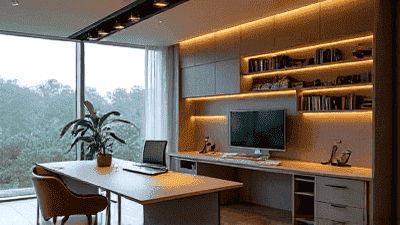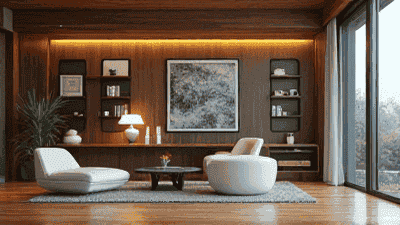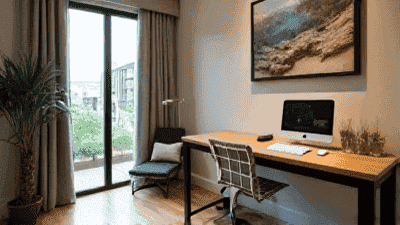
In recent years, the concept of a home office has evolved from a simple desk and chair to a fully functional, tech-enabled workspace. With the rise of smart home technology, it’s now possible to create a fully automated home office that boosts productivity, enhances comfort, and simplifies daily tasks. Whether you’re a remote worker, a freelancer, or someone who occasionally works from home, automating your home office can make a world of difference.
Before diving into the tips, let’s first understand why automation is worth considering for your home office:
Now, let’s explore the steps to create a fully automated home office.

The foundation of any home office is the desk, and automating it can significantly improve your work experience. Here are some ways to make your desk smarter:
Invest in a sit-stand desk that can be adjusted with the touch of a button. These desks promote better posture and allow you to switch between sitting and standing throughout the day, reducing fatigue and improving focus.
Incorporate wireless charging pads into your desk setup to keep your devices powered up without the hassle of cables. Many smart desks come with built-in wireless charging pads, or you can add them separately.
Choose a desk with built-in smart lighting that can be controlled via an app or voice commands. Adjust the brightness and color temperature to match your needs, whether you’re working during the day or late at night.
Automate cable management with smart cable organizers that can retract or extend as needed. This keeps your workspace tidy and prevents clutter from disrupting your workflow.
Lighting plays a crucial role in creating a productive and comfortable work environment. Here’s how to automate your home office lighting:
Replace traditional bulbs with smart LED bulbs or light strips that can be controlled via an app or voice commands. These bulbs allow you to adjust brightness, color temperature, and even color to create the perfect ambiance for your work.
Install motion-activated lights in your office to save energy and ensure you never walk into a dark room. These lights can turn on automatically when you enter your office and turn off when you leave.
Use smart lighting systems that simulate natural light to improve focus and reduce eye strain. These systems can adjust the light throughout the day to mimic the changing color temperature of sunlight.
Create preset lighting scenes for different tasks, such as "Focus Mode" for deep work, "Relax Mode" for breaks, and "Meeting Mode" for video calls. These scenes can be activated with a single tap or voice command.

Maintaining a comfortable temperature in your home office is essential for productivity. Here’s how to automate climate control:
Install a smart thermostat that learns your schedule and adjusts the temperature based on your preferences. You can control it remotely via an app or integrate it with voice assistants like Alexa or Google Assistant.
If your home office is part of a larger space, consider setting up zoned heating and cooling to ensure your office is always at the right temperature. Smart thermostats can manage multiple zones independently.
Use smart fans or ventilation systems to improve air circulation in your office. These devices can be programmed to turn on or off based on temperature or humidity levels.
If your home office is in a separate room, consider using smart space heaters or air conditioners that can be controlled via an app or voice commands.
Audio and video technology can enhance your home office experience, whether you’re attending virtual meetings or listening to music. Here’s how to automate these systems:
Place smart speakers in your office to play music, podcasts, or white noise that helps you concentrate. These speakers can also be used for voice commands to control other smart devices in your office.
Invest in noise-canceling systems or smart soundbars that can block out distracting noises and enhance the audio quality of your virtual meetings.
Use smart displays for video calls, presentations, or as a second monitor. These devices can double as digital assistants, allowing you to check your calendar, set reminders, or control smart devices with a touch.
Install smart curtains or blinds that can be programmed to open and close at specific times. This allows you to control natural light and privacy without interrupting your work.

Automating your workflow can save time and reduce stress. Here are some smart tools to consider:
Use smart plugs to automate the power supply to your devices. For example, you can schedule your printer to turn on only when you need it or set your desk lamp to turn off automatically at the end of the workday.
Invest in smart power strips that allow you to control multiple devices with a single app or voice command. These strips often come with built-in surge protection and energy monitoring.
Integrate smart task management tools like Trello, Asana, or Todoist with your calendar and voice assistants to keep track of deadlines, meetings, and to-do lists.
Use cloud storage solutions like Google Drive or Dropbox to automate file backups and syncs. Set up workflows using automation tools like Zapier or IFTTT to streamline repetitive tasks, such as sending email reminders or updating spreadsheets.
A secure home office is essential for peace of mind. Here’s how to automate security in your workspace:
Install smart locks on your office door to control access remotely. You can grant temporary access to guests or staff and receive alerts when someone enters your office.
Use smart security cameras to monitor your office space. These cameras can send live feeds to your phone and alert you to any unusual activity.
Place motion sensors in your office to trigger lights, cameras, or alarms when movement is detected. This can deter intruders and notify you of any unexpected visitors.
Set up a smart alarm system that can be integrated with other devices in your home office. For example, the alarm can turn on the lights and lock the door if an intruder is detected.
To fully automate your home office, it’s important to create a cohesive ecosystem where all your devices work seamlessly together. Here’s how to achieve that:
Select a central hub, such as Google Nest Hub, Amazon Echo, or Apple HomePod, to control all your smart devices from one place. This hub can be used to manage lights, temperature, security, and more.
Ensure all your smart devices are compatible with your chosen ecosystem. For example, if you’re using Google Assistant, opt for devices that work with the Google Home app.
Set up routines and automations that trigger multiple devices simultaneously. For example, a "Good Morning" routine can turn on the lights, adjust the thermostat, and play your favorite playlist as you start your workday.
Incorporate voice control into your home office setup to manage devices without interrupting your work. Use voice commands to turn on the lights, adjust the temperature, or start a virtual meeting.
Finally, don’t forget to personalize your home office with smart decor that enhances both functionality and aesthetics:
Use smart art frames or digital displays that can cycle through artwork, photos, or motivational quotes. These displays can be controlled via an app or voice commands.
Incorporate smart planters that automatically water and care for your office plants. These devices can monitor soil moisture and light levels to ensure your plants stay healthy.
Choose smart furniture, such as ergonomic chairs or adjustable shelves, that can be customized to fit your needs. Some chairs even come with built-in massagers or heating elements for added comfort.
Use smart clocks or digital calendars that display the time, weather, and your schedule. These devices can sync with your calendar and provide reminders for meetings or deadlines.
Creating a fully automated home office is not just about incorporating the latest technology; it’s about designing a workspace that enhances productivity, comfort, and efficiency. By following these tips and integrating smart devices into your home office, you can create a workspace that adapts to your needs and simplifies your daily routine. From smart desks and lighting to automated workflows and security systems, the possibilities are endless. Embrace the future of work by transforming your home office into a fully automated, tech-savvy haven.